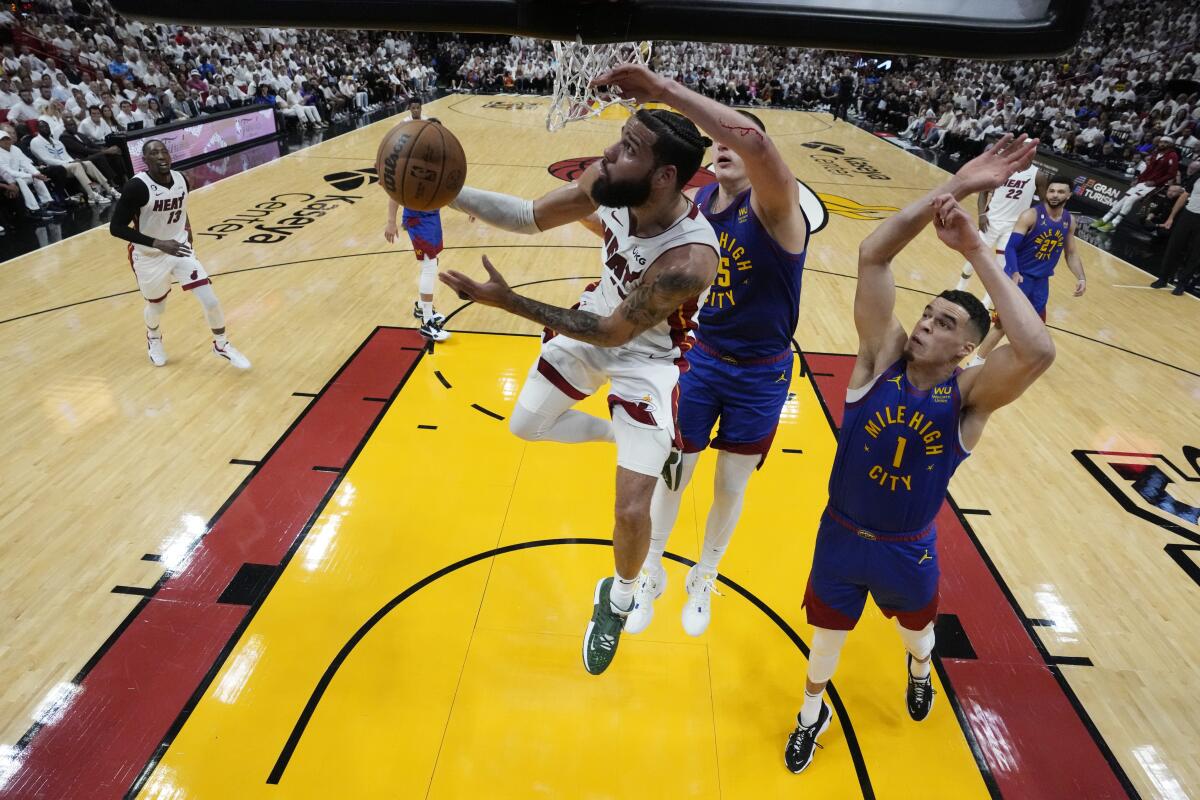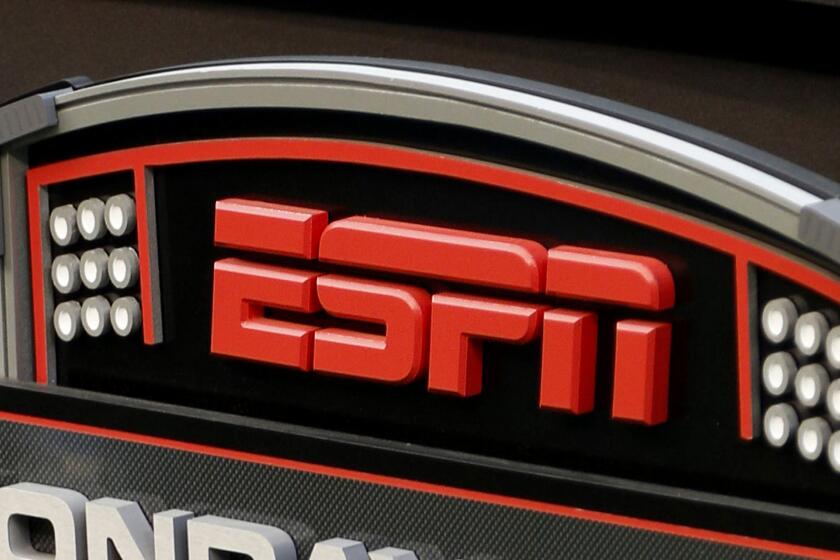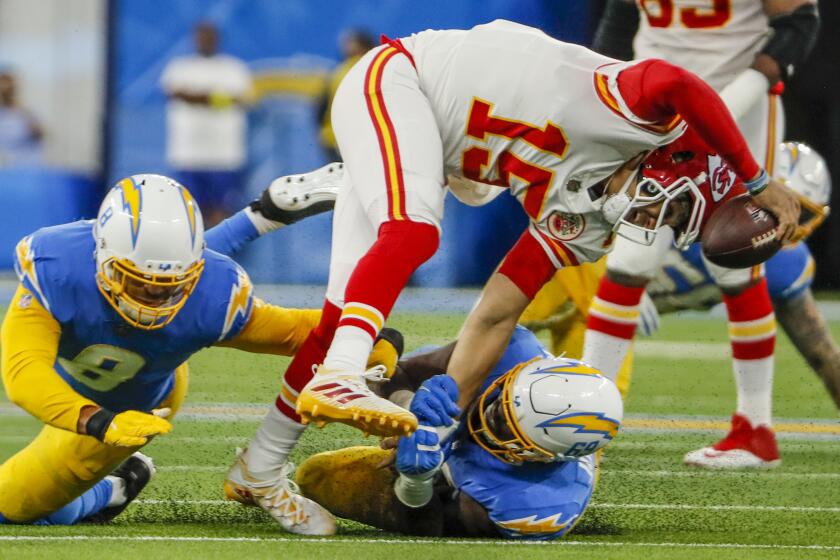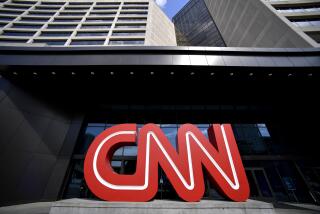Can ESPN survive while cable TV dies?

- Share via
ESPN has long been called “The Worldwide Leader in Sports,” and for decades no network had it better in the cable business.
When consumers pay their cable or satellite TV bills, networks get a cut, and the biggest portion is passed along to ESPN whether you watch it or not. It has long been the most expensive part of the pay-TV bundle, currently getting close to $9 per subscriber.
Live NFL, NBA and Major League Baseball contests and the authoritative highlight show “SportsCenter” made the Walt Disney Co. unit’s package of channels a must-have for households with sports fans.
ESPN commanded fee increases every time it negotiated new deals with pay-TV providers. The dollars pulled in helped fund the growth of Disney over the years as it became an entertainment behemoth, acquiring Marvel, Pixar and Lucasfilm.
But the TV game has changed over the last decade — and now Disney is scrambling to come up with a new playbook.
Consumers moving to streaming video has led to the decline of the pay-TV business, which has lost 25 million customers in the last five years alone. And with ESPN being the biggest player, it’s being disproportionately hurt. ESPN is now in 73 million homes, down from 98.5 million in 2013.
“The future of the pay-TV bundle is at a critical moment with ESPN playing the starring role,” is how media analysts at MoffettNathanson described the situation in a report issued Friday.
It’s not just cord-cutting. Young fans now turn to YouTube and other sites for sports highlights, making “SportsCenter” less of a must-see, and the network is more dependent than ever on exclusive live events, which are increasingly expensive as deep-pocketed tech giants such as Amazon, Apple and Google chase after them for their streaming businesses.
Wall Street investors are concerned about ESPN being in a vise-like squeeze, losing pay-TV customers while its costs for live sports programming are escalating. Some analysts have suggested spinning the unit off, as they see its uncertain future as a drag on Disney’s stock price.
Consumers also are directly feeling the impact of the pressure Disney is under.
Disney pulled ESPN and its other channels off of Charter Communications’ cable systems on Thursday, leaving millions of viewers in Los Angeles and New York without U.S. Open coverage and many college football games, as the company failed to reach an agreement on a new carriage deal.
While such disputes are not unusual, Charter executives held an investor call Friday where they said the standoff shows how the current pay-TV model is “broken.” Prices for cable subscriptions are going up while providers have to compete with cheaper video streaming services that offer the same programming.
Meanwhile, Disney is looking at ways to mitigate rising programming costs for ESPN. Walt Disney Co. Chief Executive Bob Iger said he would consider taking on a partner in ESPN to help ease the burden and has tapped former top Disney executives Tom Staggs and Kevin Mayer to help analyze strategic options for the unit.
ESPN executives declined to comment publicly.
But executives inside the network maintain that they can navigate the shifting tides of the business.
Sports are the most valuable programming on TV, as viewers watch them live and sit through the commercials. ESPN still has the rights to many major properties locked up for years, including the NFL through 2032 (with two Super Bowl games), Major League Baseball through 2028, SEC college football and basketball through 2034 and the NHL through 2027.
As other networks saw their ratings swoon, ESPN’s audience levels were up 12% in 2022, and they’ve increased 7% so far in 2023, according to Nielsen data, despite the decline in pay-TV households.
Iger told analysts that ad sales for ESPN are running 10% over last year in what has been a soft market for TV commercial time. The network’s digital business continues to grow and its presence on social media is strong, with ESPN being the most popular sports brand on TikTok.
While consumers are cutting the cord, ESPN has still been able to extract fee increases from pay-TV services. According to S&P Global Market Intelligence data, ESPN is projected to take in $7.8 billion in pay-TV subscriber revenue in 2023. The figure is slightly more than in 2022, and is up 10% from $7.1 billion in 2016, even though ESPN reaches 20 million fewer homes, which speaks to the value of live sports in the cable bundle.
The sports media unit remains profitable and part of Disney. But expect the company to keep a close eye on its financial performance.
But the challenges ahead that threaten the company’s prosperity are real. Based on conversations with several current and former executives at the company, here are the burning questions on ESPN’s future.
How soon will consumers be able to purchase the flagship ESPN channels without a pay-TV subscription through its streaming app ESPN+ and how much will it cost?
The best guess internally is 2025, but there is no rush, especially if the decline in pay-TV homes levels off at 55 million or more. ESPN wants to put off disrupting the steady stream of subscriber fees as long as possible. As soon as Disney decides to make ESPN a direct-to-consumer channel, cord-cutting among sports fans is likely to increase, which will make pricing tricky.
“The lower you go on the price for an ESPN direct-to-consumer service, the more you accelerate cord-cutting,” said Philip Cusick, a managing director at JP Morgan.
The day of the ESPN flagship channel being offered to ESPN+ streaming customers who don’t have cable or satellite services is coming. Disney is seeking the option to offer the channel as a direct-to-consumer streaming service in every new carriage deal it does with a pay-TV provider.
But not every carrier is going along. Charter wants to offer ESPN+ at no additional cost for its existing cable subscribers. Disney is resisting that proposal.
Steele is parting ways with the cable sports giant after settling a lawsuit in which she claimed her 1st Amendment rights were violated.
“We have proposed creative ways to make Disney’s direct-to-consumer services available to their Spectrum TV subscribers, including opportunities for new and flexible packages where those services become a focal point of what the consumer might choose,” a Disney representative said in a statement.
The standoff shows that ESPN’s transition from cable to streaming won’t be easy. The company is currently researching how much to charge for an ESPN direct-to-consumer product. It’s expected to be in the range of $20 to $30 per month, making it more expensive than any of the major streaming services such as Netflix, Max or Peacock. But Disney has to charge enough to offset the loss of cable subscribers that is likely to occur. (The company did not comment on future pricing for ESPN+.)
Who are the possible partners for ESPN?
ESPN and Disney management have said they are looking for a strategic partner that can provide additional distribution and content for its streaming service ESPN+. Based on that criteria it could partner with Amazon — which has already been the subject of speculation — Apple or Google, which carries the NFL’s “Sunday Ticket” package starting this season.
“You’ve kind of narrowed it down to one of the three,” said Cusick. “I can’t think of anyone else who would be an interesting partner in both distribution and content.”
A representative for ESPN declined comment on the status of any discussions about a partnership.
The league’s popular channel showing scoring plays will be available with a subscription to NFL+ Premium starting this season.
If ratings and ad revenue are increasing, why did ESPN fire some of its big-name talent such as NBA Finals analyst Jeff Van Gundy and NFL sideline reporter Suzy Kolber?
The cuts were mandated across the entire Walt Disney Co., which was looking to reduce costs as it struggles to make its streaming business profitable. ESPN was given a number and told to reach it. ESPN Chairman Jimmy Pitaro chose to cut some high-salaried on-air personalities and commentators — a total of 20 — instead of dozens of employees behind the scenes.
When the 2019 NFL draft took over downtown Nashville last month, ESPN became a city within the city, with more than 600 staffers and freelancers on site, and its top executive, Jimmy Pitaro, surveyed the scene like its mayor.
The network also is seeking new cost-effective ways to bring in recognizable talent. ESPN recently made a deal to carry “The Pat McAfee Show,” an irreverent sports talk program with the former NFL player that is a hit on YouTube. The cost for the show - reportedly $85 million over five years - includes not just the services of the host but the entire production, a first for the company. ESPN believes it will be profitable on day one as a result.

With streaming companies competing for media rights to major sports, what are the chances of ESPN holding onto the NBA, which is up in 2025?
The company has made it clear that it will aggressively attempt to retain its NBA package, which includes the Finals. Disney has a strong relationship with the league. During last season’s Finals, Iger could be seen sitting courtside with NBA Commissioner Adam Silver, whose name has been floated as a future Disney chief executive.
But Amazon, which now has exclusive rights to the NFL’s “Thursday Night Football” package and is considering expanding its sports offerings for its Prime Video service, wants in on the NBA action as well.
One scenario mentioned by sports TV executives has the league staying with ESPN and Turner Broadcasting’s cable channels due to their still-potent ability to give their games and stars visibility. Amazon could get a new national package that will take some NBA games from the regional sports networks, ESPN and Turner and combine them with the newly announced In-Season Tournament. The tournament has 67 games, including all 30 teams, who will play for a new in-season trophy, the NBA Cup, in November.
Why is ESPN getting into the online gambling business?
It’s part of the company’s plan to become less reliant on cable subscriptions, the source of revenue that is slowly eroding. ESPN is getting $1.5 billion over the next decade to license its famous brand name to Penn Entertainment for an online gambling app, ESPN Bet. ESPN also is getting $500 million in warrants to take a stake in Penn.
While Disney executives have said in the past that it was unlikely ESPN would be directly involved in the online gaming business, cultural acceptance of sports betting has been rapid. Online sports betting now is legal in 30 states and ESPN has been providing odds data in its programming and online links to gaming apps such as DraftKings and BetMGM for years.
Still, insiders at the company say the Penn arrangement will be an adjustment, as on-air talent will be integrated into marketing and promotion efforts for Bet ESPN.
Reports on ESPN can move the odds of contests. Having the renowned brand name on a betting app has led the company to update its internal policies on gaming to make sure it’s above reproach.
It’s possible that ESPN employees and talent will be prohibited from using ESPN Bet or perhaps from betting at all. The network also will step up public service announcements urging viewers to play responsibly and to ensure that Penn’s technology can identify problem gamblers.
More to Read
Inside the business of entertainment
The Wide Shot brings you news, analysis and insights on everything from streaming wars to production — and what it all means for the future.
You may occasionally receive promotional content from the Los Angeles Times.














